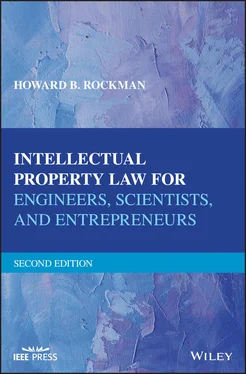An issued patent grant describes and illustrates the covered invention, and its advantages over the “prior art,” and also includes specifically worded “claims” that define the metes and bounds of the protection afforded by the patent grant. If a competing device or process falls within the definition set forth in a patent’s claim or claims, or comprises equivalent structure, the competing device infringes the patent. However, I am getting ahead of myself—the topic of patent infringement will be covered later.
1.2.2 Trademarks and Service Marks
Trademarks, services marks, collective membership marks, trade dress or product configuration, trade names and the like are indicia of origin of one’s products or services. These indicia are directed toward the protection of the reputation and goodwill of the manufacturer of a product or a provider of services, who uses a mark or symbol distinguishing the source of origin of its products or services from those of another manufacturer or service provider. These marks may comprise a name, logo, symbol, product shape, container shape, or other distinctive and non‐functional feature of a product or service which indicates that a certain supplier or group is the sole source for that particular brand of product or service, and the supplier or group stands behind the quality and reputation of the particular product or service. Rights in the exclusive use of the mark are protected to avoid the likelihood of consumer confusion in the marketplace as to the source of the goods or services they purchase, thereby protecting the public against fraud by the second user of a confusingly similar mark.
A trademark or service mark registration application must be submitted to the government (the USPTO in the United States) to obtain federal registration, and sets forth both the identifying mark and those goods or services with which the mark is, or is intended to be, used. A trademark never stands alone. A trademark or service mark is always considered as an adjective, modifying the goods or services to which it pertains. Thus, “Scotch tape” is proper usage, as long as the “Scotch” is followed by the identifying word “tape.” When used, a trademark or service mark should always be followed by the descriptive term of the associated goods or services.
Trademarks and service marks may also be protected in the United States and certain other common law countries without registration, if long usage and advertising of the mark has advised the public that the name or symbol has been adopted as a distinctive mark by its owner. As discussed later, each state of the United States has a trademark/service mark registration system directed to marks for goods and services that do not travel across state lines, such as a dental office, for example.
A copyright is a form of intellectual property that protects the expression of authorship or artistic rendition of the author or creator, but does not protect the idea or concept upon which the expression is based. A concept for doing something cannot be protected by copyright, but the fixation, or expression of that concept, can be protected. For example, the concept of writing a book about tornado hunters is not protectable. However, a book or film about tornado hunters is a “fixation” of the author’s expression, and the expression, but not the concept, is protectable under the copyright statutes.
Copyright protection is normally easier and less expensive to obtain than either patent or trademark protection. Under existing law, the creator of a copyrightable work obtains an intangible copyright in the work immediately upon the fixation of the work in a tangible medium of expression. To obtain a U.S. registration of that copyright, which provides tangible evidence of the existence of the copyright, an application setting forth, among other things, the author’s name, the identity of the work to be protected, and its date of creation are submitted on an appropriate form to the Register of Copyrights, along with a deposit sample of the work. The Register of Copyrights works under the aegis of the U.S. Library of Congress. The application is subjected to an examination procedure, which is much quicker than the examination of patent or trademark applications, because there is no examination for novelty or likelihood of confusion as compared to existing copyrighted works. The copyright application must indicate which portions of the work are original and which are not. This permits the public to ascertain which portions are protected and which remain in the public domain. Copyrights are used to protect books, films, videos, works of art, sculptures, and, more recently, choreography and software.
It is possible to overlap protection between the copyright and patent laws. For example, a novel, useful and non‐obvious computer program may be protectable under both patent laws and the copyright laws. The expression of an algorithm or formula can be protected as a literary work under the copyright law. In addition, a novel method for controlling a machine by use of an algorithm may qualify for patent protection.
As discussed later in this text, patents and copyrights expire after a term of years, while trade secret protection does not. As long as the information covered by a trade secret umbrella remains secret, that information is protected from improper discovery or use by others, unless the secret is independently discovered, as by reverse engineering, or otherwise lawfully made public by someone else. Where the secret is very difficult to discover and the owner is willing to maintain security to ensure its secrecy, trade secret protection is a valuable option and has no endpoint.
However, once the trade secret becomes known, there is no way to restore secret status. If the secret is discoverable upon reviewing the articles in which the secret is used, trade secret protection is useless. In such cases, patent or copyright protection should be considered instead. Unlike patents and copyrights and trademarks, until recently, there was no federal law regulating trade secret protection in the United States. However, in 2016, the U.S. Congress enacted a federal law to protect trade secrets, which is discussed in Chapter 27of this text. Each state has its own trade secret protection law, and if it is determined that the best way to protect your intellectual property is through the trade secret law, an attorney familiar with this area of your state law should be consulted in the state or states in which you are operating. In the State of Illinois, where I practice, the state legislature has enacted the Illinois Trade Secrets Act, which is currently in effect. This Act sets forth what types of subject matter are considered as trade secrets, such as secret processes, formulas, customer lists, confidential future business plans, etc., and how they are protected. Even if a particular state has not enacted a statute granting trade secret protection, the common law may be available in that state to enforce trade secret rights against misappropriation once the secret is created.
1.2.5 Mask Works for Semiconductors
In 1984, the U.S. Congress enacted a law to protect mask works used in creating semiconductor microprocessor chips. This law became part of the Federal Copyright Statute. Chapter 26of this text describes in detail how mask work protection can be obtained for semiconductor chips.
1.3 WHICH FORM OF INTELLECTUAL PROPERTY PROTECTION TO USE?
Depending on the nature of the technological project you are engaged in, one or several of the vehicles of intellectual property may be advisable to use. In some situations, you may not have any choice. If the subject matter of protection is a book or manuscript, patent or trademark protection cannot be obtained. For example, book titles other than periodical titles cannot be the subject of trademark registration, since each book title is descriptive of the precise book sold under that title. In some situations, multiple forms of protection will be available. In the case of a novel form of packaging, both article and design patent protection may be available, covering a novel construction embedded in the packaging, as well as the aesthetic outward design of the package. Also, the name of the product on the packaging would be susceptible to trademark protection, while the graphics used on the packaging label could be protected under copyright laws.
Читать дальше












